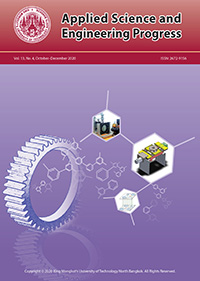Simulation of Die-swell Flow for Wet Powder Mass Extrusion in Pharmaceutical Process
Main Article Content
Abstract
The simulation of extrusion spheronization in pharmaceutical industry is constructed to develop drug product. This process has four steps: mixing, extrusion, spheronization and drying. The mixing combines water and powder together with high shear until it creates strong bonds to gather powder particles in liquid solution. The work is focused on extrusion of wet powder masses, which can be classified as non-Newtonian fluid. The continuous creeping flow motion is explained in terms of the Navier-stokes equation and the rheological behavior is represented by Oldroyd-B constitutive model. The solution is solved with numerical scheme through the semi-implicit Taylor-Galerkin/pressure-correction finite element method in two-dimensional axisymmetric system under the conditions of isothermal, incompressible, laminar flows. In addition, the velocity gradient recovery and the streamline-upwind/Petrov-Galerkin schemes are applied to improve the convergence of solution. Finally, the swelling ratio of extruded product is presented to compare with the experimental results in drug production. The extrudate size obtained from computation shows agreement with both the experiment and the analytical figures. The extrudate size for experiment matches well with computational method with a discrepancy to the analytical formula. The swelling ratio of free surface for experiment is slightly different from numerical prediction with an error of 1% whilst the error between analytical and experimental values reaches 6%. For the next simulation to duplicate the feasible products, the new setting can be checked by this simulation before the set-up of real experiment.
Article Details
References
[2] S. Muley, T. Nandgude, and S. Poddar, “Extrusion– spheronization a promising pelletization technique: In-depth review,” Asian Journal of Pharmaceutical Sciences, vol. 11, no. 6, pp. 684– 699, 2016.
[3] J. Chatchawalsaisin, P. Podczeck, and J. M. Newton, “The preparation by extrusion/spheronization and the properties of pellets containing drugs, microcrystalline cellulose and glyceryl monostearate,” European Journal of Pharmaceutical Sciences, vol. 24, pp. 35–48, 2005.
[4] J. Thiry, F. Krier, and B. Evrard, “A review of pharmaceutical extrusion: Critical process parameters and scaling-up,” International Journal of Pharmaceutics, vol. 479, pp. 227–240, 2015.
[5] J. Breitenbach, “Melt extrusion: From process to drug delivery technology,” European Journal of Pharmaceutics and Biopharmaceutics, vol. 54, no. 2, pp. 107–117, 2002.
[6] M. Maniruzzaman, J. S. Boateng, M. J. Snowden, and D. Douroumis, “A review of hot-melt extrusion: Process technology to pharmaceutical products,” ISRN Pharmaceutics, vol. 2012, pp. 1–9, 2012.
[7] M. J. Crochet and R. Keunings, “Die swell of a maxwell fluid numerical prediction,” Journal of Non-Newtonian Fluid Mechanics, vol. 7, pp. 199–212, 1980.
[8] W. J. Silliman and L. E. Scriven, “Separating flow near a static contact line: Slip at a wall and shape of a free surface,” Journal of Computational Physics, vol. 34, no. 3, pp. 287–313, 1980.
[9] N. Phan-Thien, “Influence of wall slip on extrudate swell: A boundary element investigation,” Journal of Non-Newtonian Fluid Mechanics, vol. 26, pp. 327–340, 1988.
[10] A. Karagiannis, A. N. Hrymak, and J. Vlachopoulos, “Three-dimensional nonisothermal extrusion flows,” Rheologica Acta, vol. 28, pp. 121–133, 1989.
[11] V. Ngamaramvaranggul and M. F. Webster, “Viscoelastic simulation of stick-slip and die swell flows,” International Journal for Numerical Methods in Fluids, vol. 36, pp. 539–595, 2001.
[12] S. J. Chapman, A. D. Fitt, and C. P. Please, “Extrusion of power-law shear-thinning fluids with small exponent,” International Journal of Non-Linear Mechanics, vol. 32, no. 1, pp. 187–199, 1997.
[13] N. Thongjub, B. Puangkird, and V. Ngamaramvaranggul, “Simulation of slip effects with 4:1 contraction flow for Oldroyd-B fluid,” Asian International Journal of Science and Technology in Production and Manufacturing Engineering, vol. 6, no. 3, pp. 19–28, 2013.
[14] N. Thongjub and V. Ngamaramvaranggul, “Simulation of die-swell flow for Oldroyd-B model with feedback semi-implicit Taylor Galerkin finite element method,” KMUTNB International Journal of Applied Science Technology, vol. 8, no. 1, pp. 55–63, 2015.
[15] V. Ngamaramvaranggul and M. F. Webster, “Simulation of pressure-tooling wire-coating flow with Phan-Thien/Tanner models,” International Journal for Numerical Methods in Fluids, vol. 38, pp. 677–710, 2002.
[16] V. Ngamaramvaranggul and S. Thenissara, “The contraction point for Phan-Thien/Tanner model of tube-tooling wire-coating flow,” International journal of Physical and Mathematical Science, vol. 4, no. 4, pp. 627–631, 2010.
[17] R. I. Tanner, “A theory of die swell,” Journal of Polymer Science Part A-2, vol. 8, no. 12, pp. 2067–2078, 1970.


